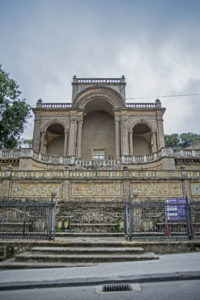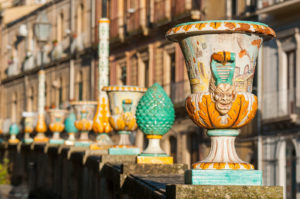In Caltagirone, traditional pottery production is linked to a thousand-year-old history dating back to ancient times.
According to the Italian archaeologist
Paolo Orsi
the production of
maiolica
preceded the arrival of the Arabs, but we know for sure that their arrival in the 9th century increased production, thanks to the introduction of a new technique – glazing – which made the pottery waterproof and more resistant.
A few centuries later, during the Spanish rule of Alfonso of Aragon, pottery trade had greatly developed and allowed artisans to sell their ceramics all over the island.
Unfortunately, the earthquake of 1693 interrupted the potters’ activity and destroyed many of the floors made with the maiolica of Caltagirone.
Today some of the fragments are preserved in the Museum of Ceramics.


After the earthquake,
decorative motifs
were replaced in order to make trade flourish again. In the 19th century, however, with the introduction of cement, the production of maiolica stopped.
The potters’ centuries-old activity ended when the last master potters disappeared in the 1930s.
In 1918 Don
Luigi Sturzo
founded the Istituto d’Arte della Ceramica (Institute of Ceramic Art) and saved a tradition that seemed destined to be lost. In 1965 the Museum of Ceramics was inaugurated, a safe place that preserved and protected a priceless cultural heritage.
